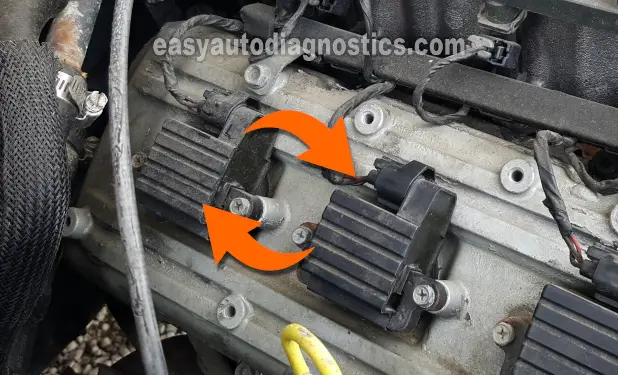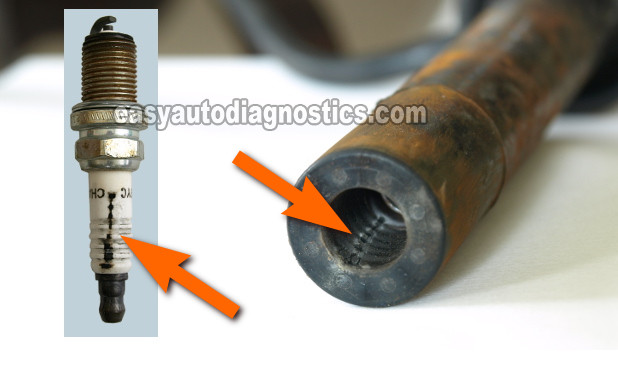TEST 5: Testing The Activation Signal Without A Multimeter

If you don't have a multimeter that can read Hertz frequency, then the best way to check for the presence of the ignition coil's activation signal is by simply swapping out the non-sparking ignition coil with a good-sparking ignition coil.
If the good-sparking ignition coil sparks when connected to the non-sparking ignition coil's electrical connector, then you can conclude that the activation signal is present in the connector.
Let's get testing:
- 1
Remove the COP coil that did not spark and set it aside.
- 2
Remove one of the adjacent COP ignition coils that does spark.
- 3
Now connect the COP ignition coil (that sparks) to your HEI spark tester and then connect it to the electrical connector of the COP coil that does not spark.
- 4
When all is ready, have your trusty assistant crank the engine.
- 5
The good ignition coil should spark.
Let's interpret you test result:
CASE 1: You got spark. This is the correct test result and confirms that the activation signal is present in the connector of the non-sparking ignition coil.
You can conclude the ignition coil is bad and needs to be replaced if you have:
- Made sure that it's not sparking (TEST 1).
- Made sure that it's getting 10 to 12 Volts (TEST 2).
- Made sure that it's getting Ground (TEST 3).
- Made sure that it's getting an activation signal (this test section).
If you need to replace the ignition coil, check out my recommendations here: Where To Buy The Ignition Coils And Save.
CASE 2: You got NO spark. Re-check all of your connections and repeat the test again. If still no spark, then this results eliminates the ignition coil as the source of the no-spark condition/misfire, since without the activation signal the ignition coil will not fire spark.
TEST 6: Checking For Carbon Tracks

If your 3.2L Isuzu Amigo, Isuzu Rodeo, Isuzu Trooper or Honda Passport is experiencing a misfire condition and all of the ignition coils are good, then the most likely causes are:
- The spark plug boots and spark plugs have developed carbon tracks.
- The spark plugs and spark plug boots are swimming in engine oil.
The two conditions listed above are a very common occurrence in this type of Coil-On-Plug ignition coil ignition system.
If the spark plug boots spark plugs are swimming in engine oil, it's usually due to the valve cover gasket leaking oil into the spark plug tubes. This oil will cause the ignition system to misfire and/or cause carbon tracks to form as the spark cooks the oil.
In the image above, you can see what a carbon track looks like on the spark plug boot and on the spark plug. The next step is to remove the spark plugs and spark plug boots to visually inspect them for carbon tracks and/or to see if they are all oil-soaked.
If the spark plugs are oil-soaked and/or with carbon tracks, you'll need to replace them all along with the spark plug boots. Failure to replace one without the other will only make the carbon track return and/or continue to misfire still.
Now, if no carbon tracks are visible on any of the spark plugs, or spark plug boots, then the ignition system is not the cause of your misfire condition. I would check engine compression and the fuel injectors among several things.
The following test tutorials may be of help:
- How To Test Engine Compression (3.2L Isuzu Amigo, Rodeo, Trooper).
- How To Test The Fuel Injectors (3.2L Isuzu Amigo, Rodeo, Trooper).
More 3.2L Isuzu Diagnostic Tutorials
You can find a complete list of 3.2L Isuzu tutorials in this index: Isuzu 3.2L Index Of Articles.
Here's a small sample of the tutorials you'll find in the index:
- How To Test The Isuzu 3.2L Throttle Position Sensor.
- How To Test The Isuzu Manifold Absolute Pressure (MAP) Sensor.
- Ignition Control Module Test (1992-1995 3.2L Isuzu Rodeo and Trooper).
- How To Test The GM MAF Sensor (3.1L, 3.4L, 4.3L, 5.0L and 5.7L).
- For GM MAF sensor equipped 3.2L Isuzu Rodeo.

If this info saved the day, buy me a beer!

